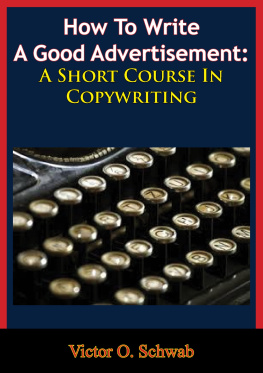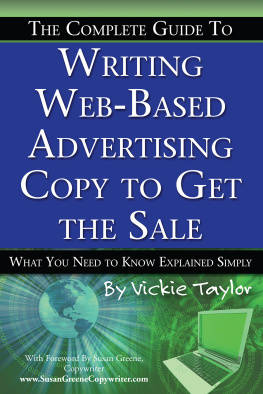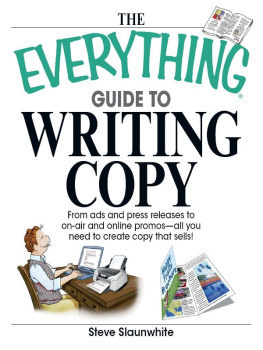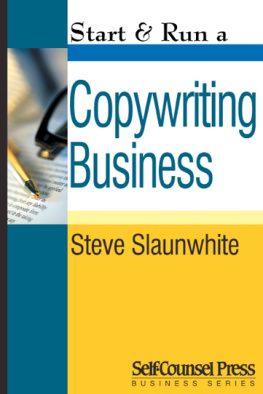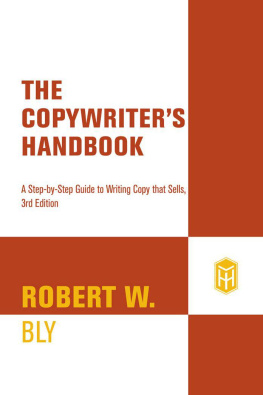

This edition is published by PICKLE PARTNERS PUBLISHINGwww.pp-publishing.com
To join our mailing list for new titles or for issues with our books picklepublishing@gmail.com
Or on Facebook
Text originally published in 1942 under the same title.
Pickle Partners Publishing 2015, all rights reserved. No part of this publication may be reproduced, stored in a retrieval system or transmitted by any means, electrical, mechanical or otherwise without the written permission of the copyright holder.
Publishers Note
Although in most cases we have retained the Authors original spelling and grammar to authentically reproduce the work of the Author and the original intent of such material, some additional notes and clarifications have been added for the modern readers benefit.
We have also made every effort to include all maps and illustrations of the original edition the limitations of formatting do not allow of including larger maps, we will upload as many of these maps as possible.
HOW TO WRITE A GOOD ADVERTISEMENT:
A SHORT COURSE IN COPYWRITING
BY
VICTOR O. SCHWAB
TABLE OF CONTENTS
Contents
DEDICATION
To my wife,
VILMA NOBLE SCHWAB,
without whose constant and confounded
Ive taken the cover off the typewriter; get going
I would never have finished writing this book
PREFACE
This book might well have carried the subtitle Or 44 Years in the Copy Department instead of its present one. Even a copywriter, whose breed is not noteworthy for arithmetical prowess, could not escape arriving at the conclusion that the number of years from 1917 to 1961 totals forty-four. And, Heaven help me!, for that seeming aeon of time the major interest of the author has been advertising copygood, bad, and indifferent.
That a large measure of this past experience has been associated with a particularly demanding kind of advertising copy may, as will be explained, be an advantageous circumstance for the reader of this book, regardless of what type of copywriting job confronts him.
For the subject of the book is not the writing of mail order copy. Its sole purpose is to lend a hand to any copywriter (or student of copywriting) whose ambition is to create advertisements which are more resultful, no matter what the product is or how and where it is sold.
As to why the authors background of experience may represent an advantageous circumstance for such copywriters, I will leave to an infinitely more capable pen than minethat of no less an authority than Claude G. Hopkins, one of the greatest copywriters of general advertising who ever lived: Mail order advertising is difficult. But it is educational. It keeps one on his mettle. It fixes ones viewpoint on cost and result. The advertising-writer learns more from mail order advertising than from any other.
Therefore, if you are looking for guidance specifically concerned with the writing of mail order advertising, this is not your book. On the other hand, if in the writing of any type of advertising you want more of your copy to achieve the selling effectiveness imperative for any mail order man who wants to continue eating heartily, this book may prove helpful to you. At any rate, you are the person for whom it was written.
Much of its information will probably recall to your mind the aphorism, We need not so much to be instructed as to be reminded. And thats all to the good. Finally, and appertaining to the passages which are reminiscent in nature, the author has tried to avoid any necessity for later having to admit, like Mark Twain, that When I was very young I could remember anything, whether it happened or not. But now I am older and I can only remember the latter.
VICTOR O. SCHWAB
INTRODUCTION
The advertisement itself is the keystone in the arch of sales. Most sales difficulties (for example, problems of dealer distribution, cooperation, and brand switching) actually hark right back to impotent advertisements. They were too easily resistible; simply not good enough to make people see, read, and act upon them: to go out and demand the product advertised and no other.
Poor copy cannot overcome faults or gaps in dealer distribution; it cannot even cash in on the finest dealer setups. But good copy can, and does, surmount many dealer difficulties, making them secondary, and selling in spite of them.
Therefore, since either the blame for failure or the credit for success in many sales campaigns can rightly be laid at the doorstep of the advertisements themselves, the first five chapters of this book concentrate upon certain basic elements of a good advertisement. This is essential, because, as Cond Nast once stated, The more factors we do not know, the more important it is for us to isolate those very few factors which we count on.
What are these fundamentals? Five of them are discussed in our first chapters. They are:
(1) Get Attention;
(2) Show People an Advantage;
(3) Prove It;
(4) Persuade People to Grasp This Advantage;
(5) Ask for Action.
Most advertising copywriters know these fundamentals. Many of us practice them. Some of us should get back to them. Whether one is now studying to go into the field of copywriting, whether he is new in the craft, or whether he has been a practitioner in it for years, his knowledge and practice of these fundamentals will determine the extent of his success. As Daniel Defoe said, An old and experienced pilot loses a ship by his assurance and over-confidence of his knowledge as effectively as the young pilot does by his ignorance and want of experience.
So this book will strip down to fundamentals, try to forget the furbelows. For, as time goes on, every line of creative work gets cluttered up with impressive jargon and off-the-beam technicalities, with professional palaver that strays far away from the main objective. Someone has said, Whenever people are particularly muddled in their thinking they invent big words to cover their confusion.
Yet, after all, is advertising itself really such a complicated thing? Its basic purpose is simple: to make people buy a product or a service. Not just to make them pause, or admire, or even merely to believe. For advertising is nothing but an expense (not an investment) unless it gets the kind of action desired by the advertiser.
Thats a very clear purpose. But in practicethats where the fuzziness comes in. And the result: Beautiful examples of the art of advertising are produced, printed, admiredand, page after page, flipped over by the public.
CHAPTER 1GET ATTENTION
There are five fundamentals in the writing of a good advertisement:
1. Get Attention
2. Show People an Advantage
3. Prove It
4. Persuade People to Grasp This Advantage
5. Ask for Action
An advertisement cannot stimulate sales if it is not read; it cannot be read if it is not seen; and it will not be seen unless it can Get Attention. Thats the round robin which Daniel Starch must have had in mind when he wrote The attention-value of an advertisement is approximately twice as important as the actual convincingness of the test itself.
YOUTHE UNINVITED GUEST
Do not underestimate the fierce competition you face in getting attention. Nobody in the world (except you) is waiting for your advertisement to appear. Everybody in the world (except you) would much rather read the news, comics, stories, articles, editorials or even the obituaries.
Next page
